Is does your baby cry, struggle, or scream during diaper changes? You aren’t alone. According to the American Academy of Pediatrics, wet or dirty diapers are one of the top reasons babies cry, second only to being hungry.
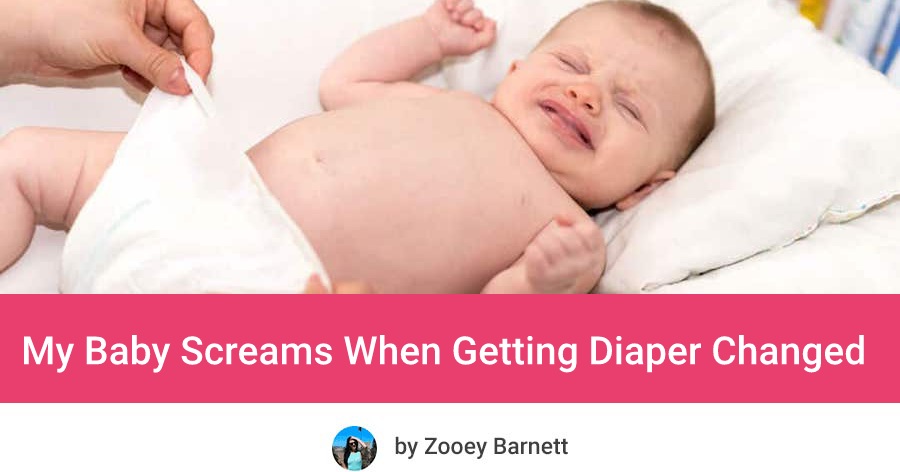
Does this sound familiar: you put your little one down on the changing table and they start squirming, screaming, kicking and nearly roll off the table?
Do they let out piercing cries during diaper changes? Are they hard to soothe after a diaper change, fussy or cry for several minutes afterward?
I know that seeing that your baby cries at diaper changes, can leave you feeling frustrated, or even heart-broken. Are you looking for some tips to make the diaper changing process less traumatic for you both?
If you said yes to any of the above, then this article is for you.
This article gets into why babies hate diaper changes and offers tips to make it a better experience for you both.
A crying baby (or a screaming one) is never fun, especially when it’s necessary to change diapers 5-8 times a day – or more.
Remember that most parents face some period within the first year when baby hates getting their diaper changed. It’s normal, but there are thing you can do to help.
Babies cry. This is their form of communication until they start talking and expressing themselves.
In this article I will share some tips to help reduce crying during diaper changing and perhaps even give the nappy change a positive tone. I will also explain what things you should avoid doing – one of them is a common mistake that most moms do without even thinking about it!
This article is not a substitute for medical advice or consultation.
At What Age Do Babies Start Fighting Diaper Changes?
Fighting diaper changes can happen at any stage through the first 18 months of your baby’s life, depending on the reason for why babies hate diaper changes.
Newborns may hate feeling restricted, while older babies may want to show off their new skills of rolling and sitting up, and hate being put down on their back.
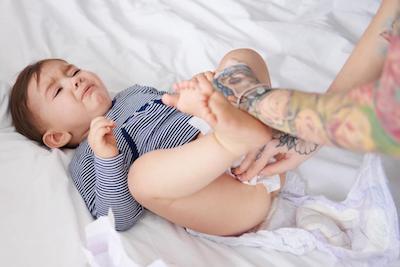
Why Does My Baby Scream During Diaper Changes?
Some of the main reasons1 a baby screams during diaper changes include:
-
Feeling Cold
Cool air, cold hands, or a chilly plastic changing pad are all colder than a baby’s body temperature. Feeling cold is a common reason why many babies cry during a diaper change.
Don’t forget that wet baby wipes also feel quite cold against a baby’s bum.
-
Discomfort
This could be due to a poor-fitting diaper, or simply not wanting to wear anything (especially newborns).
A top reason that a newborn baby cries when getting a diaper changed is because of feeling restricted. Remember, compared to Mama’s warm and cosy womb, a nappy probably feels very uncomfortable.
They could also have gas or acid reflux which is exacerbated by lying on their back.
-
Rash / Irritation
You may not see the rash coming on – but your baby can sure feel it! Some babies have more sensitive skin than others, and even urine can bring on irritation.
Always look at your baby’s bum at every diaper change to check for the signs of a rash coming on, and use diaper cream or other skin ointments to help treat it fast.
-
Hunger
Hunger is actually the number one reason for a baby to cry.
Pay attention to hunger cues to determine if your little one can actually wait for that bottle, or if the diaper change needs to wait until after baby has been fed.
-
Bright Lights
This is especially important for night-time changes. Remember, your baby is looking up at the ceiling, so that light is much brighter for them than for you.
If you can avoid turning on the lights for nighttime diaper changes (or switch to red lights or dim night lights) that will also be less disruptive to baby’s sleep.
-
Overstimulation
Right along with bright lights is the issue of an overstimulated baby. While lights are more of a concern during naps or sleep, overstimulation can be an issue during any time of day.
Each baby is different, so you have to determine if your baby is easily stimulated by colors, sounds and textures. Physical or visual stimulation both occur during a diaper change: the baby’s body is feeling a lot of sensations from your hands, the baby wipes, being dressed in clothes, etc.
Even if they are not easily over stimulated, if they were just happily at play with blocks or tummy time, and two seconds later they are half dressed, cold and facing up, it might be overwhelming for a little baby.
-
Position
Most parents lay their babies on their back for diaper changes, which makes sense hygenically, but not every baby enjoys lying on their back with their feet lifted into the air.
The position of their body might be the reason why your baby cries during diaper changes.
-
Control
Most babies go through a phase where they undo their own diaper and run around without it. This is pretty normal and means they are exercising control over their bodies (it might end up being messy until they get potty trained, but remember – its a sign of independence, too).
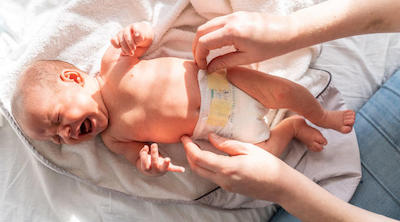
How Do I Stop My Baby From Crying During Diaper Change?
Here what the best tricks you should try to stop your baby from crying2 during diaper change:
1. Change Your Technique
To change a diaper, many parents use the same technique: place baby on their back and raise up baby’s legs to access the dirty bum, right?
But if this causes your baby discomfort, then you need a new diaper changing routine. Try rolling your baby on to one side, then the other. You’ll do this two consecutive times – once to clean, the second time to fit the new, clean diaper.
Another technique sways baby’s hips from side to side instead of up and down, as this is more soothing to little ones.
A new changing technique might take longer (and perhaps be a little messier) but it also could result in a happier baby!
2. Make Your Changing Table More Comfortable
Try placing a folded towel atop your changing pad or changing table. The extra cushioning will be more comfortable and if a cold changing pad was the culprit to why baby cries, you’ve got your solution!
Never leave your baby unattended at the diaper changing station.
3. Warm Your Hands Before Changing A Diaper
Your hands might be cold! Make sure to warm them up before changing diapers to keep your child from crying.
Try keeping a hot water bottle nearby (but out of reach of your baby) to warm up your hands before each change.
4. Keep Baby’s Upper Body Covered
If you are fully undressing your baby for each change (clothes like pajamas or body suit) your baby’s body is exposed to the cool air.
Keep a small blanket or swaddle nearby to lay over their chest and belly to keep baby a little warmer.
5. Change Up Your Routine
A hungry baby may cry during diaper changes – not because of the diapers, but because they just cannot wait to eat!
If you suspect this is the case, try changing your regular routine. Babies grow so fast and they can quickly need to eat or sleep at new times. Try moving their feeding time earlier, or change them after a feeding, instead of before.
6. Create A Diaper Changing Routine
Even a newborn wants to know what is happening, even if they can’t express themselves.
Mom, you can help make diaper changes easier by creating a diaper changing routine. Once you set a routine with cues they can recognize, baby will know what to expect and anticipate the diaper change coming.
Some ideas include:
- Try to change baby’s diaper at the same location as much as possible.
- Sing the same song as you walk to the nursery or while changing.
- Let baby hold a clean diaper while you change them.
7. Frequent Changes
There are several reasons for crying during diaper changes, but none of them change the fact that you just have to CHANGE THAT DIAPER, right? It can make you feel like delaying diaper changes, but this is not a good idea.
If you are letting urine-only diapers sit a bit longer and waiting for bowel movements (poops) before you change that dirty nappy, this could be exacerbating the problem. Sensitive skin react to the acid in urine and it causes irritation or chaffing when stuck in a wet diaper.
In this case, it’s best to do frequent changes and apply diaper cream at every change.
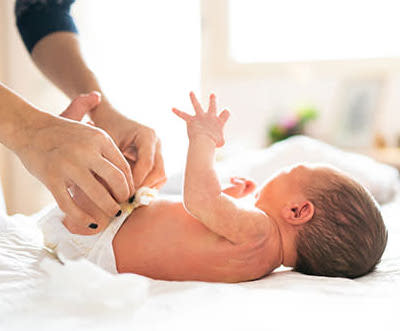
8. Get The Right Size
Make sure you are putting your baby in the correct size and see how it impacts how baby cries during changes.
Weight ranges are a guide for purchasing the correct diapers, but its not the only factor to look at. See how the diapers fit around the waist and thighs of your child. If the diaper leaves a mark, or the tabs to close the diaper are beyond their indicated space, the diaper is likely too tight.
Different brands have different indicators for tab spacing around the waist. Some have vertical lines, others have colored markings. Make sure to check the packaging for your particular type of diapers to determine the proper fit for your little one.
By the way, getting the right size of diapers is super important for preventing diaper blowouts.
9. Try A New Brand Or Type Of Diapers
If your baby gets frequent rashes or shows signs of skin irritation, try a new brand. It might be the diaper material or various reasons why a particular diaper doesn’t work for your baby.
You may want to try out some of the non-toxic and natural baby diapers that are less likely to cause skin reaction.
The good news is, if baby cries because of the diaper brand, this is the easiest solution on the list!
You could also try out a different style: if you use disposables, try some reusable diapers and see if it helps.
10. Use Pull-Up Style Diapers
When a baby starts walking it is common for them to want to walk or run everywhere. They don’t have time to sit or lie down – even for a diaper change. This can be hard for mom, who may feel like she has to wrestle her child in order to get them into a clean diaper.
One of the easiest ways to deal with this is to change to pull-up style diapers. It’s very easy
11. Make Diaper Changes Fun
Another approach is to make changing baby’s diaper more fun!
Give the things to look at, hang an overhead mobile or pictures at their eye-level, near their head.
Use toys as distractions. Keeping some small toys beside the changing table can help you both deal better with diaper changes.
Play with your baby. You don’t need everything to be toys – sing songs, making funny faces and tickling toes are all ways to give it a positive tone.
12. Change Your Nursery To Be A Calm Environment
However, if you are worried that your baby cries because they are overstimulated during diaper changes, don’t add music or toys, but go for less.
Have dim lighting and try to stay calm yourself (take a deep breath, your baby can feel your energy, Mom). Soothe your baby first in a quiet room and talk slowly about what you are doing for each step of the diaper change.
13. Use Your Voice
Your baby loves YOU, mom, so make eye contact and use your voice to soothe your crying baby. Talk to explain what you are doing, or sing a favorite song.
14. Do Baby Massage
If your baby has gas or acid reflux, lying on their back for a diaper change might hurt.
Remember, a newborn needs help even to burp, so consider helping baby release that gas before doing a diaper change.
One way is to do a baby massage: lie them on their belly and stroke their back, or place them on their back and do bicycle rolls with their legs to release gas.
In general, doing an infant massage can help your little one to calm down. I recommend doing this massage with a natural baby oil that is safe for newborns and infants.
15. Get A Wipe Warmer
Now, generally I think wipe warmers are silly and unnecessary – until I visited Maine in February! For folks who live in northern climates that experience cold (and I mean coooold) winters, I can see the benefit to warming up wipes in advance.
If you think your crying baby could like warmed-up wipes – dear Mama, go for it! You do what is best for you and your baby.
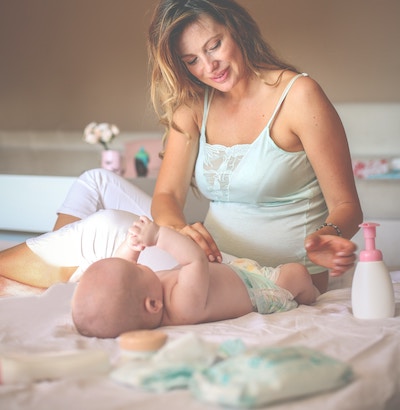
What If My Baby Still Screams During Diaper Changes?
If you’ve ruled out the common culprits of hunger, cold and wanting to exert their independence, but your baby continues to cry during diaper changes, then you might need to try a different approach.
Many parents always lift up the bum to do a diaper change, but this might be uncomfortable. Consider helping your baby to release gas first, and try using the ‘hip-sway method’ instead of lifting up.
If you feel that your baby is excessively crying, don’t be shy to ask your doctor3. You, as the parent, know your baby best and you should go with your intuition if you think something is not quite right.
The purpose of this article is informative. It’s not a substitute for professional medical advice or medical care. Remember: safety first! Consult your doctor/pediatrician in case of any doubts. The author of this article does not accept any responsibility for any liability, loss or risk, personal or otherwise, incurred as a consequence, directly or indirectly, from any information or advice contained here.
Resources:
https://www.pampers.com/
https://pathways.org/
https://themamanurse.com/

